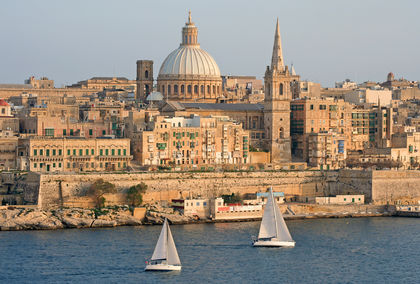MALTA

The Republic of Malta
Repubblika Ta' Malta
COUNTRY OVERVIEW
LOCATION AND SIZE.
Malta consists of a series of small islands in the Mediterranean Sea, 97 kilometers (60 miles) south of the Italian territory of Sicily and 288 kilometers (179 miles) north of Africa. It is at the crossroads of Africa, Europe, and the Middle East. While Malta is an archipelago (a group of islands), only the 3 largest islands—Malta, Gozo, and Comino—are inhabited. Malta's land area is just 316 square kilometers (122 square miles), and the coastline of the Maltese islands is 140 kilometers (87 miles). Malta is about twice the size of Washington, D.C. The largest city is Valletta, which is also the nation's capital, and the second largest is Sliema.
POPULATION.
The population of Malta was estimated to be 391,670 in July of 2000. The Maltese people are mainly descendants of ancient Phoenicians and Carthaginians who originally settled the islands. There are also descendants of Italians and other Mediterranean people in Malta, in addition to British influences from the colonial period. Nonetheless, the population is mainly homogeneous and overwhelmingly Roman Catholic (91 percent).
Malta's population growth rate is low (0.74 percent) and the population is aging. In 2000, 13 percent were over the age of 65, while only 20 percent were under the age of 15. The birth rate is 12.75 births per 1,000 people or 1.92 children born per woman. In 2000 the death rate was 7.7 deaths per 1,000, but the infant mortality rate was low at 5.94 deaths per 1,000 births. Life expectancy is 75.49 years for males and 80.62 for females. The Maltese emigration rate is low. Each year there are 2.39 migrants per 1,000 inhabitants.
The country is one of the most urban and densely populated nations in the world. The United States has 21 people per square kilometer (55 per square mile) compared to Malta's population density of 1,160 people per square kilometer (3,000 per square mile).
DEPENDENCIES
Malta has no territories or colonies.
BIBLIOGRAPHY
Boulton, Susie. Malta and Gozo. New York: NTC, 2000.
Department of Information Malta. <http://www.doi.gov.mt> . Accessed September 2001.
MERHBA: Welcome to the Official Website of the Maltese Government. <http://www.magnet.mt> . Accessed September 2001.
Spiteri, Edward J. An Island in Transition: The Economic Transformation of Malta From a British Crown Colony to an Independent Democratic Republic. Valletta, Malta: Progress Press, 1997.
U.S. Central Intelligence Agency. World Factbook 2001. <http://www.odci.gov/cia/publications/factbook/index.html> . Accessed September 2001.
U.S. Department of State. FY 2001 Country Commercial Guide: Malta. <http://www.state.gov/www/about_state/business/com_guides/2001/europe/index.html> . Accessed September 2001.
Xuereb, Peter G., editor. Malta, the European Union and the Mediterranean: Closer Relations in the Wider Context. Valletta, Malta: University of Malta, 1998.
—Tom Lansford
CAPITAL:
Valletta.
MONETARY UNIT:
Maltese lira (LM). One Maltese lira equals 100 cents. Each cent is subdivided into 10 mils. There are coins of 2, 3, and 5 mils and of 1, 2, 5, 10, 25, and 50 cents. There are notes of 2, 5, 10, and 20 lira.
CHIEF EXPORTS:
Machinery and transport equipment, manufactured goods.
CHIEF IMPORTS:
Machinery and transport equipment, manufactured and semi-manufactured goods, food, drink, tobacco.
GROSS DOMESTIC PRODUCT:
US$5.6 billion (purchasing power parity, 2000 est.).
BALANCE OF TRADE:
Exports: US$2 billion (f.o.b., 2000). Imports: US$2.6 billion (f.o.b., 2000).
I need to use this website as a reference for an assignment.
Can you please tell me who is the author or organisation responsible for this information and the date when it was last updated?
Thanks & regards,
Charles